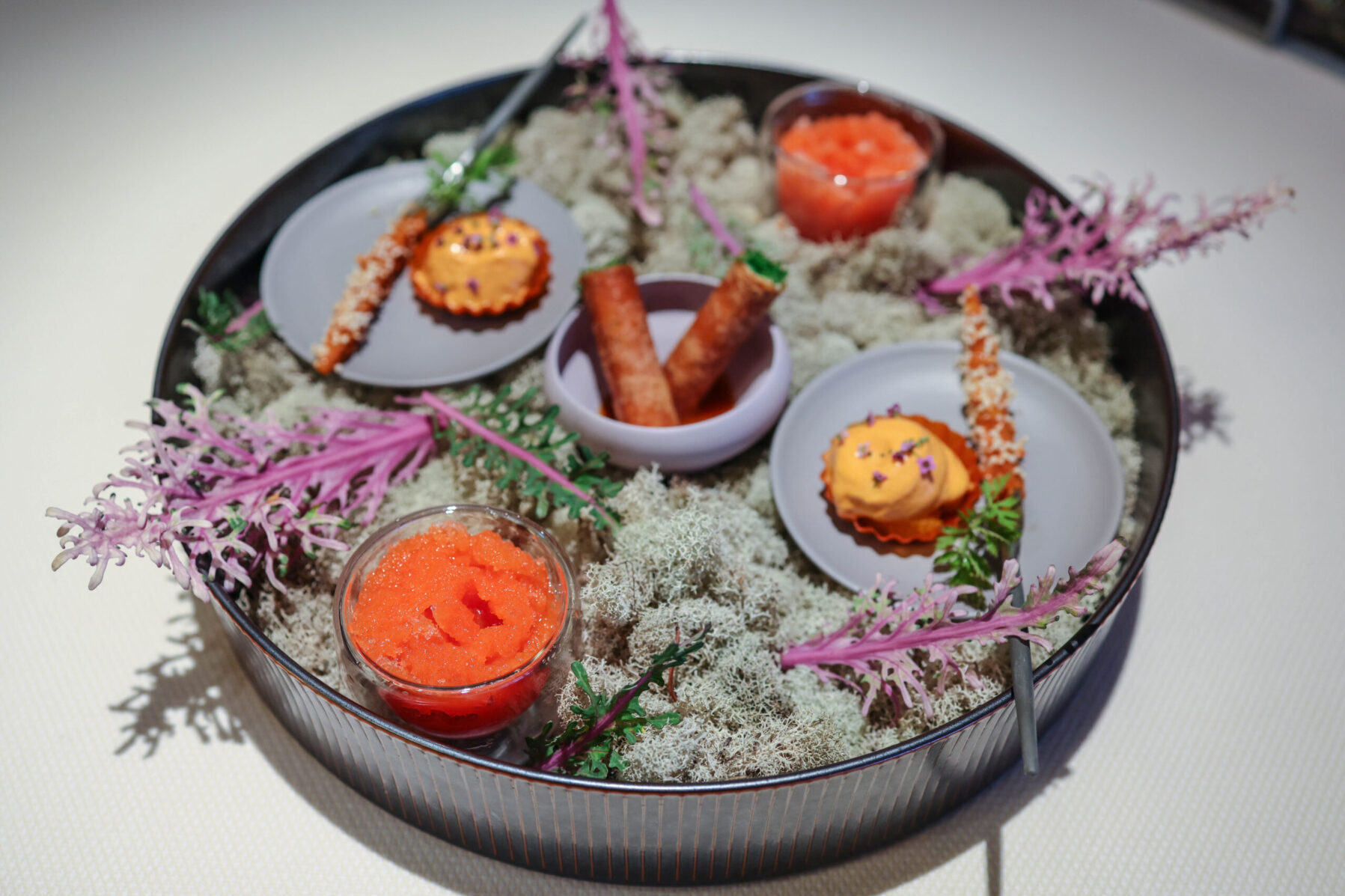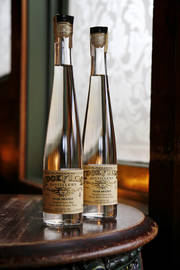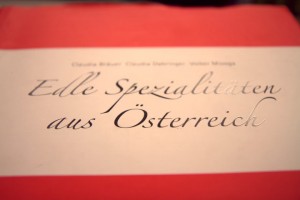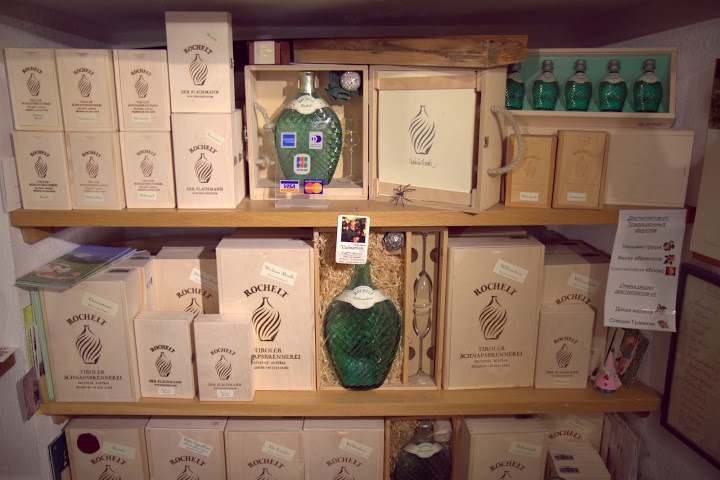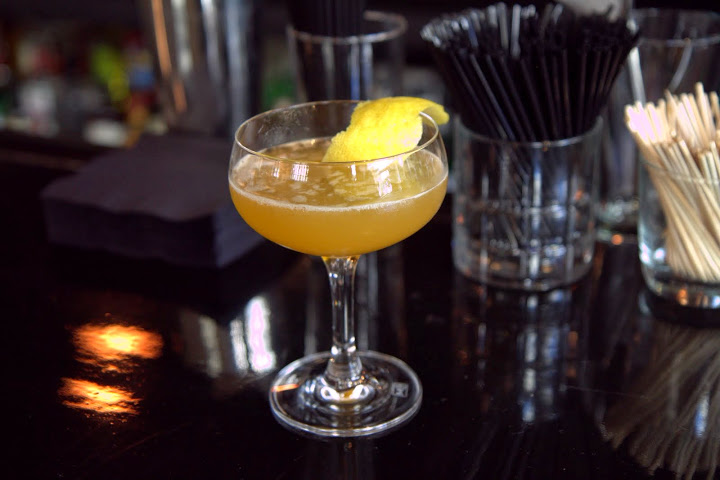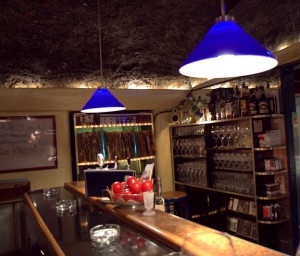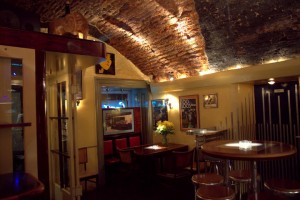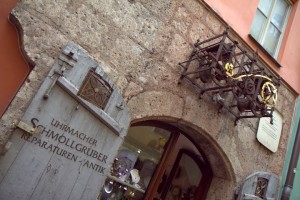Whatever association you have with the word Schnapps, or Schnaps, as it is known in Germanic countries (the word means “swallow”), it likely isn’t good. Sour apple, pucker, fruit flavors… you might think of cheap, sugary liqueurs in unnatural colors. But this, my friends, is not real schnaps.
In Austria, Switzerland, Germany, and the French region of Alsace, schnaps, edelbrande or brand (as in brandy), is another thing entirely. The French term is eaux de vie, among my favorite spirits categories and the supreme example of distilled fruits. A classic fruit eau de vie/schnaps will never be too sweet or cloying, but rather fresh, sometimes clean or lush. It takes tons of fruit to produce a mere bottle, so efforts — and costs — to make it are intense. The fruit is macerated, fermented, and distilled, typically in a grain liquor base, sometimes a liqueur with sugar added, other times a clear spirit.
One of the most classic eaux de vie, and my favorite strain, is pear, typically made from Williams pears (the same as Bartlett), aka Poire Williams. I judge American eaux de vie producers by their pear, and the best producers make a crisp version, tart with the taste of fresh pear skin, sometimes floral. In the US, I love the pear brandies/eaux de vie (and plenty of other eaux de vie) from St. George, Clear Creek (which, after decades as an independent distillery, was just sold to a larger spirits corporation so I would keep an eye out for changes in quality), Old World Spirits, McMenamins, and Stone Barn Brandyworks. While decidedly American, these are fine examples of quality eaux de vie.
The great American pioneers in brandy? Jörg Rupf, who founded St. George in 1982, brought Old World methods and precision to California from his native Germany with his brandies. Another US/California pioneer important to mention in a brandy discussion – known for his Cognac/Armagnac-quality spirits rather than for fruit brandies – is Hubert Germain-Robin, who founded Germain-Robin in 1982.
In Austria, there are such fantastic brands that would surely be in demand among spirits lovers in the States were we able to get our hands on them. What would it take to get more of them imported here?
I wish I spoke/read German anyway, especially while thumbing through this fantastic book, Edle Spezialitäten in Österreich, a giant, coffee table book outlining every schnaps/brandy and wine producer in Austria via photos and facts (available at Sporer in Salzburg, below). If only someone would translate this invaluable book into English.
Many schnaps made an impression this visit to Austria. One is Golles, produced in the village of Riegersburg in the region of Styria, near Hungarian and Slovenian borders. Alois Gölles distills his schnaps in copper stills, the ones I tasted boasting a rustic elegance and welcome earthiness, among the most lauded in the country.
Reisetbauer in Axberg, northeast of Salzburg, is a beloved, award-winning brand from Hans Reisetbauer, who leased barely 4 acres from his father’s farmland to grow fruit used strictly for schnaps. While many producers source their fruit from other parts of the country and Europe, he has direct supervision and control over fruits grown on his land. Reistebauer schnaps are clean and refined, fragrant and unique, like carrot schnaps, which reminds me of St. George’s experimental carrot brandy years back which I wish was released.
I was intrigued by and wanted to taste more Siegfried Herzog schnaps. The surprisingly refined, nutty Nusserl or hazelnut schnaps was so brilliant, I bought a bottle at Sporer in Salzburg (see below). Another Sporer win was a recommend from the shop owner: forward-thinking Hochstrasser bottles in sleek black with galaxy/space labels. They produce a range of products from zirbenz (pine liqueur) to banana liqueurs. Their fruit vakuum-destillat, or vacuum distilled, schnaps is a fascinating line. It has been explained to me as a slow-heat, slow “cook” process akin to a sous vide concept where maximum flavors are taken from fresh fruit without “overcooking”. The result, particularly with Hochstrasser’s Rote Williams Birne (red pear schnaps) is tart, clean, tasting of pear skins. I also brought home this stunner, wishing I could have transported the entire line home with me.
Rochelt is the most exciting of the many schnaps I tried and is respected – almost worshiped – in Austria. Just 15 minutes drive outside Innsbruck, Gunter Rochelt (who opened the distillery in 1989) and his son-in-law, Alexander Rainer, who now runs the business with the three Rochelt daughters, Julia, Annia and Teresa, distills a wholly different kind of schnaps. While still using fruits, from wild rowanberry to morello cherry, these are boozy, high proof schnaps, often 50% ABV or more. Bottled at cask strength and blessedly not sweet, they feel like the whisk(e)y of schnaps. Bracing and complex, I bought bottles of quince and Poire Williams, marveling at the nuance and depth of each. This is fruit liqueur from a completely fresh angle. There’s a whole wall of Rochelt for sale at Culinarium in Innsbruck (see below).
Taking an overview of the category, the range of schnaps is broad. German schnaps are often made from pears (Poire Williams or Williamsbirne), apples (often combined with pears and called Obstwasser), plums (Zwetschgenwasser), cherries (Kirschwasser), apricots (Marillenschnaps), Himbeergeist (a raspberry spirit). But non-fruit spirits are also referred to as schnaps, including popular kräuterlikör (herbal liqueurs) such as Underberg, Wurzelpeter, and the infamous Jägermeister. Bierbrand is another ubiquitous category in Germanic countries, essentially a brandy that is distilled beer. One quality brand available in the US is pür•geist bierbrand from pür spirits.
As you might suspect, we are missing out here in the states by having little access to the majority of schnaps. While I’d highly recommend traveling to Austria, I’d also love to see demand grow amongst knowledgeable industry folk (bar managers, writers, consumers, etc.) for these products, with importers and distributors working to bring more to the US. It’s time distilled fruits, nuts and the like had their day… I suspect there are many would-be fans. Consider Austria an underrated diamond in the spirits rough.
Where to drink Schnaps in the US
In LA, you can order pours of the Golles and Reisetbauer lines at Bierbeisl, a great Austrian/German restaurant. In Sacramento, there’s a surprisingly strong selection of schnaps and Germanic liqueurs to drink neat or in cocktails at hip sausage and beer house, Lowbrau. There’s also a strong collection of Reisetbauer and a few other schnaps and Germanic liqueurs at Cafe Katja in New York‘s Lower East Side.
Trocadero Club, a newer San Francisco bar (just opened in October 2013), one of Dennis Leary’s newest spots, is ahead of the curve in its treatment of Austrian drink. Bar Manager/Partner Eric Passetti – part of the opening team for Mamacita and Delarosa and helping to run all of Leary’s bars – envisioned a bar featuring Austrian wines and schnaps. “I’m a contrarian who likes doing things other people aren’t doing,” explains Passetti. With a grandfather and great grandfather who both owned bars in San Francisco, and having bartended for 13 years himself, he wanted to do something different with this bar, noting: “The scene is exhausted as it is.”
Unfortunately, the crowds coming to the relaxed, white-walled, high ceiling bar on a grubby Tenderloin corner, are not quite there. Austrian wines have been reduced due to demand for other wines and there are really only about four schnaps, which is in part due to inaccessibility as imports. But as Passetti knows from his own research on schnaps, instead of, “being high in sugar and low in alcohol, true schnaps are higher in alcohol, lower in sugar.” He showcases schnaps in a good half of his cocktails ($10).
The Dresden shows off the subtle hops of Bierbrand with herbaceous gin, dry Italian vermouth and Green Chartreuse, while the Baroness goes a boozy-yet-elegantly sweet and bitter direction with pur spirits Bierbrand Märzan Schnaps (distilled malted barley aged in chestnut casks), sweet Italian Amaro Nonino, Tempus Fugit’s Gran Classico, and lemon juice.
Where to drink Schnaps in Austria
One of the best wine and schnaps bars in Austria (and, thus, the world?) is in Salzburg. Just a couple doors down from my wonderful apartment rental on narrow, cobblestoned-lined Steingasse street, is Fridrich. Run by Fridrich himself since 1986, I would easily call this tiny wine bar one of my favorite bars in Europe. And I’m a spirits and cocktail girl first.
Though the bar, under arched stone ceiling with glowing lighting, is intimately sexy, Fridrich almost imparts a subtle punk-rock attitude to the relaxed environs. It’s partly his expert knowledge of all things Austrian – he tasted me through the crisp, earthy notes of Nigl (pronounced nee-gel) Gelber Muskateller white wine, harvested from tiered, hillside vineyards, and likewise earthy, complex Golles schnaps. Another visit, it was a glass of lovely Stiegelman Grauburgunder Weingut, a white wine I’d loved at a restaurant in the Tyrolean-chic village of Kitzbuhel.
The other reason for Fridrich’s uniqueness is his impeccable musical tastes and expansive vinyl and CD collection, which he plays interchangeably like a sophisticated DJ. His top of the line sound system envelops the bar with a tapestry of sound.
There’s a wonderful woman who works with him, demure yet engaging, both of them offering recommendations, pours, humorous asides. Lou Reed died the last night we were in Salzburg. Fridrich told us the news, then put on Reed’s music. We all raised a glass, shedding a tender tear. It’s that kind of a bar.
The Renaissance Man and I were so inspired, we dreamed of opening our own tiny bar like this somewhere in the world: a place where you immediately feel like a local, where what is poured and what is played is of equal importance, where there is nothing to prove, only to relax, savor to feel at home.
Where to buy Schnaps in Austria
Salzburg’s schnaps/brandy shop extraordinaire is Sporer, which has been on Salzburg’s main, touristy-yet-utterly-charming shopping street, Getreidegasse, since 1903. Sporer staff are informed and passionate about schnaps and can chat about it for great lengths of time, offering samples and spot-on recommendations.
In Innsbruck, don’t miss Culinarium, a father and son-run shop that’s been around over 40 years. There’s a whole wall of nearby Rochelt (see above), and fascinating local spirits like Vir Gin, an Austrian dry gin, or Tiroler Single Malt Whisky.
